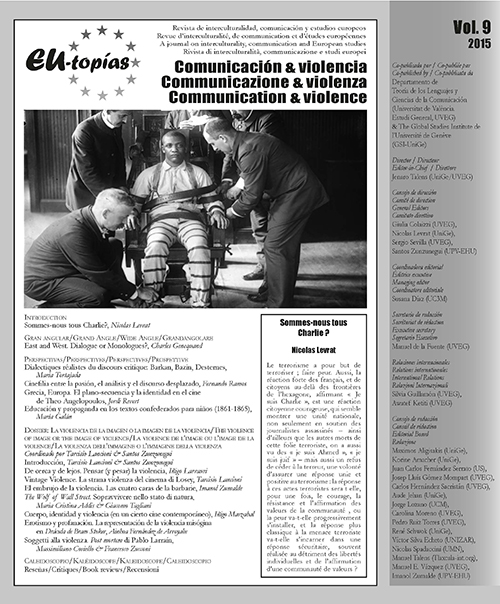De cerca y de lejos. Pensar (y pesar) la violencia
DOI:
https://doi.org/10.7203/eutopias.0.18749Keywords:
Sublime, violent image, imminent violence, immanent violence, predictability, estrangement Abstract
Abstract
There is a kind of image we call violent. One which attacks us and somehow inflicts pain from a distance. At the same time, there is a group of images we call sublime which are violent to some extent, and yet invite us to take delight in watching rather than making us close our eyes. While the former kind give rise to rejection, the latter one allows enjoyment; both groups, however, have some common features. It is precisely the way in which each group manages its own common features what invites us to propose a way to measure, weight, or at least think of, those violent images. For such purpose, we will make use of examples (audiovisual, pictorial, photographic, and sculptural) illustrating the differences between images of what we will call immanent violence and those of what we will call imminent violence.
 Downloads
Downloads
 References
References
Addison, Joseph (1991), Los placeres de la imaginación y otros ensayos de The Spectator [ed. Tonia Raquejo], Madrid: Antonio Machado.
Bazin, André (1966), ¿Qué es el cine?, Madrid: Rialp. Boltanski, Luc (1993), La souffrance à distance, Paris: Editions Métailié.
Boltanski, Luc (1993), La souffrance à distance, Paris: Editions Métailié.
Burke, Edmund (2014) [1757], Indagación filosófica sobre el origen de nuestras ideas acerca de lo sublime y de lo bello, Madrid: Alianza.
Barthes, Roland (2005), El grano de la voz. Entrevistas 1962 – 1980, Buenos Aires: Siglo XXI.
Calabrese, Omar (1989), La era neobarroca, Madrid: Cátedra.
Eisenstein, S. M. (2014), El Greco, cineasta, Barcelona: Intermedio
Demetrio, Sobre el estilo / Longino, Sobre lo sublime (1979) [ed. José García López], Madrid: Gredos.
Handke, Peter (1996), Un viaje de invierno a los ríos Danubio, Save, Morava y Drina o justicia para Serbia, Madrid: Alianza.
Juaristi, Jon (2000), Sacra némesis. Nuevas historias de nacionalistas vascos, Barcelona: Debolsillo.
Kant, Immanuel (2012) [1764], Observaciones acerca del sentimiento de lo bello y de lo sublime, Madrid: Alianza
RaqueJo, Tonia(1991),«Introducción», JosephAddison, Los placeres de la imaginación y otros ensayos de The Spectator, Madrid: Antonio Machado, pp. 15-122.
Wölfflin, Heinrich (2009) [1915], Conceptos fundamentales de la historia del arte, Madrid: Espasa-Calpe.
Downloads
Published
How to Cite
-
Abstract232
-
PDF (Español)77
Issue
Section
License
![]()
The authors conserve the copyright. All content published in EU-topías. Journal of interculturality, Communication, and European Studies are subject to the license Creative Commons Attribution-NonCommercial-ShareAlike 4.0 license. The full text of the license can be found at <http://creativecommons.org/licenses/by-nc-sa/4.0>
They may be copied, used, disseminated, transmitted and publicly displayed, provided that:
- The authorship and original source of the publication is cited (journal, publisher and URL of the work).
- They are not used for commercial purposes.
- The existence and specifications of this license of use are mentioned.
It is the responsibility of the authors to obtain the necessary permissions for images that are subject to copyright.



